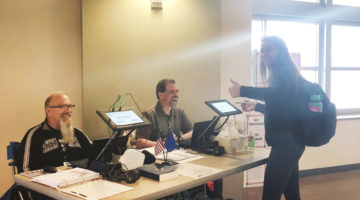With primary election season only a few short weeks away, the reality that President Obama’s tenure as the nation’s commander in chief is ceremoniously coming to end has become readily apparent in the minds of the American voters. While Americans are split on whether to celebrate or rue the end of the 44th presidency, this last week begins a 365-day countdown to the end of President Obama’s presidential campaign.
Yet, this last week also represents a monumental countdown to the beginning for one hopeful who will eventually ascend to the most powerful office in the free world. And much like the Olympic games, once every four years we watch while the hordes of voters rush to the polls and the surfeit of presidential hopefuls rush like a flock of birds to the small Midwestern state of Iowa.
Though the state is arguably nothing more than Hawkeye football and a stop-over on the way to Chicago, Iowa represents the beginning of a long journey that will encompass months of strategy, travel and billions of dollars to be spent on the road to the White House. But unlike recent years, there is an unusual trend among the response from registered party voters with the candidates representing the Republican and Democratic parties.
While in recent years the leading candidates coming into the caucus season were notably representative of their party’s visions and beliefs, there has been an interesting trend that has allowed for candidates that represent the furthest left and right of the political spectrum to lead the field. In recent cycles, presidential hopefuls like Barack Obama, Hillary Clinton, John McCain, Huckabee, Romney, etc., with few exceptions in their campaign platform, were not considered radical or extreme on their stances that aligned with the general opinion of their party.
Yet, with the surge of hopefuls like Sen. Bernie Sanders I-VT., and hairpiece-wearing billionaire Donald Trump, the reality that the radical wings of the liberal and conservative political spectrum is highlighting what is truly resonating with voters. Though still considered unlikely by many political analysts, a matchup between Sanders and Trump would create an interesting situation as the strategy to lure the masses of independent voters that (according to a 2014 Gallup survey, amounts to roughly 42 percent of registered voters) would create a political toss up if the independent or moderate voters find it more difficult to choose between two extreme candidates.
So what is fueling the fire of appeal for these campaigns? What is the variable that makes two such extreme candidates so popular? Candidates today must be exciting, energetic, spontaneous and must offer something new to the voter.
While that speaks to the philosophical nature of the American democracy as it can always be improving, this idea has served as the focal point of nearly every campaign in American history. Yet, in reality, America is far better off than it was in 2008 when President Obama took the reins. The nation was in the midst of the greatest economic downturn and highest unemployment rate in decades, Americans were losing their homes, our military power was still conducting operations in Iraq and Afghanistan and our national pride was weakened. In his eight years, whether you love him or hate him, these trends have all been reversed due to his progressive policies and executive actions even in an extremely partisan Congress. Yet, Republican candidates are wholly convinced that our president has systematically destroyed our nation, and that they are the only salvation.
In addition, Democratic candidates claim that there is still evil in our country that they, and only they, can solve with sweeping policy changes. And that right there is where the appeal of candidates like Sanders and Trump becomes so real. Their campaigns, though overly exciting and appealing, are nonetheless pseudo-optimistic. Candidates, much like Puritan preachers of colonial America, will beat to death the existence of evils like ISIS, immigration, corruption of politicians and Wall Street brokers, and will strategically offer them salvation, but only through their leadership.
In essence, these campaigns are not running on a platform of optimism, but rather capitalizing on the fears of the voters.
When Franklin Roosevelt said, “We have nothing to fear, but fear itself,” it was not an invitation for politicians to take advantage of fear as a campaign tool. Want the reality? Some politicians like Donald Trump, Ted Cruz, and others want the American populace to believe that they are constantly in peril.
When you go to the polls in November to vote for our next President, do not vote with your fears. The reality is that fear is a motivating factor in all campaigns, but it lies with the voter to look past fear and towards change for the better. Do not vote out of fear that you will be endangered physically or financially if you vote any other way, instead vote your conscious and your morals. Do not let fear win this election because it is a contradiction to everything that we hold dear as the world’s great democracy.
Jake Truscott studies political science. He can be reached on Twitter @JakeTruscott_44 and alexandraschultz@unr.edu.











